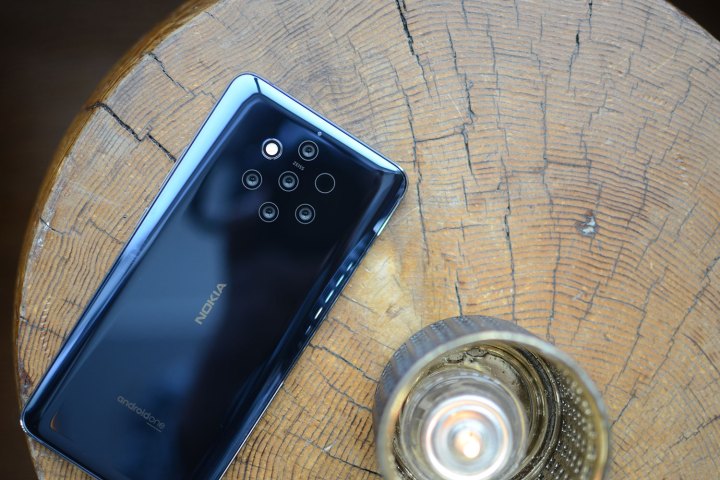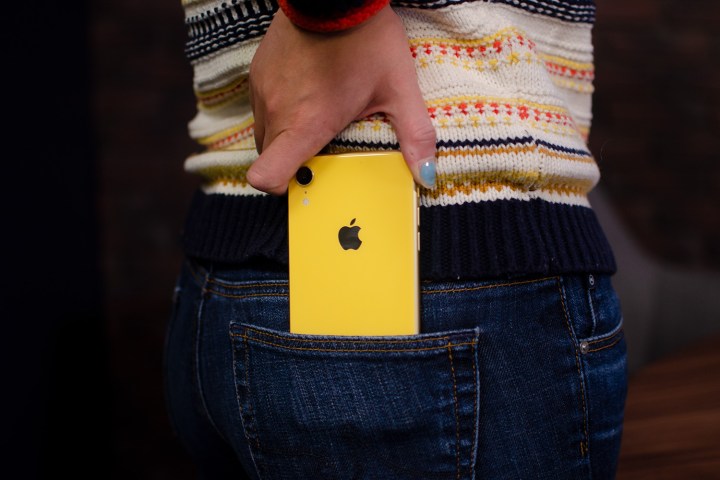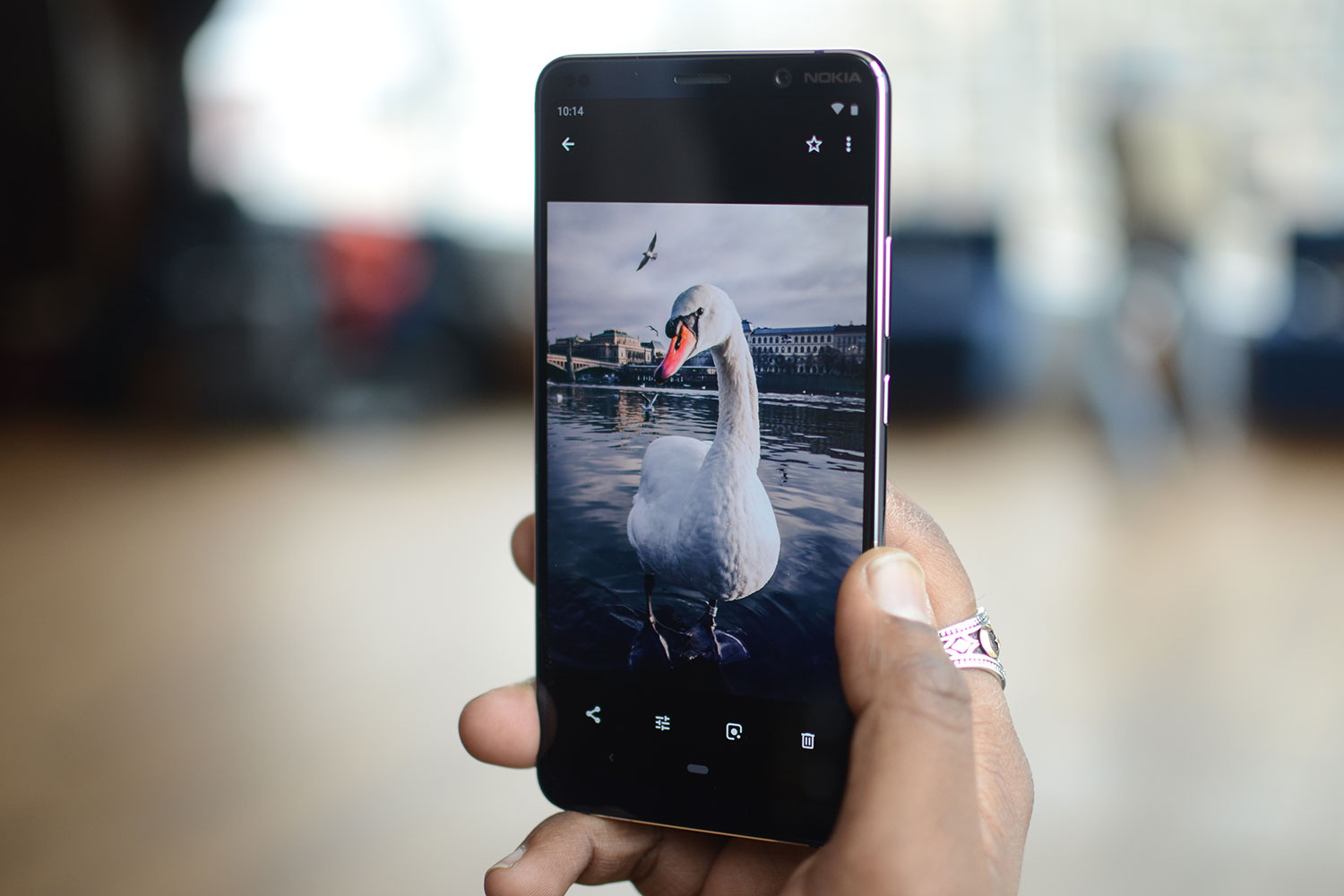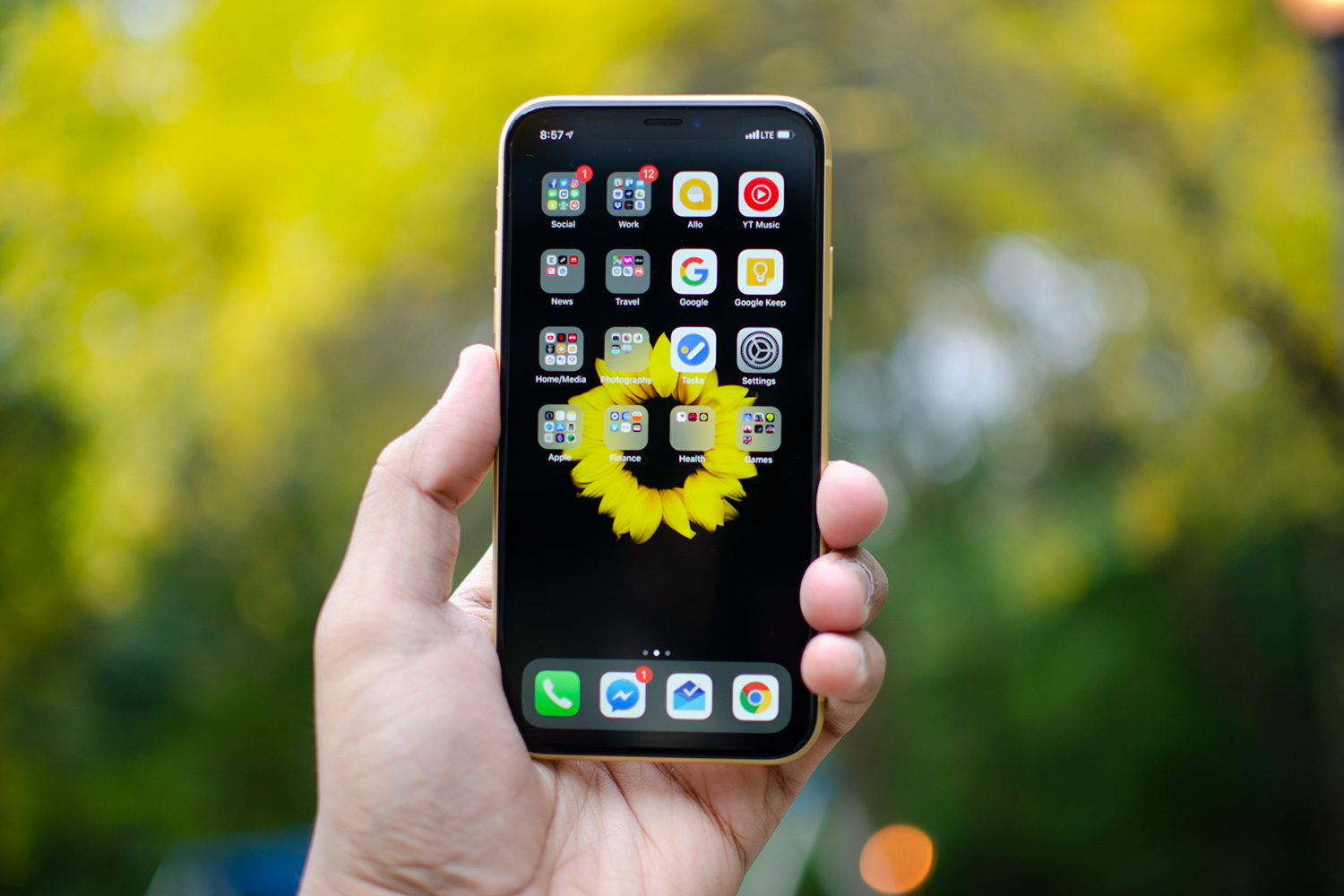
The Nokia 9 PureView was revealed at MWC 2019 — and it’s everything we dreamed it would be. With a sleek glass design and a notchless P-OLED display, the Nokia 9 PureView would have stood out even without the addition of five (yes, five) camera lenses arranged neatly in the rear glass.
At an expected $700 price, however, it has some immediate and very powerful opposition to face — the iPhone XR. This lower-priced iPhone stole our hearts last year, and it’s one of the Nokia 9’s main competitors. Which phone wins when these two go head-to-head? We found out.
Update: Read our review for our first impressions of the device, or jump to the good stuff: the first photos from the Nokia 9, thanks to a week of exclusive early access.
Specs
| Nokia 9 PureView |
iPhone XR | |
| Size | 155 x 75 x 8.0 mm (6.10 x 2.95 x 0.31 inches) | 150.9 x 75.7 x 8.3 mm (5.94 x 2.98 x 0.33 inches) |
| Weight | 172 grams (6.07 ounces) | 194 grams (6.84 ounces) |
| Screen size | 5.99-inch P-OLED | 6.1-inch Liquid Retina HD IPS LCD |
| Screen resolution | 2K screen resolution | 1792 x 828 pixels (326 pixels per inch) |
| Operating system | Android 9.0 Pie | iOS 12 |
| Storage space | ||
| MicroSD card slot | No | No |
| Tap-to-pay services | Google Pay | Apple Pay |
| Processor | Qualcomm Snapdragon 845 | Apple A12 Bionic |
| RAM | 6GB | 3GB |
| Camera | Penta-lens 12MP (two RGB lenses & three monochrome lenses) all with f/1.8 aperture rear, 20MP front | 12MP (with OIS) rear, 7MP TrueDepth front |
| Video | Up to 4K at 60 frames per second, 1080p at 60 fps | Up to 4K at 60 frames per second, 1080p at 60 fps |
| Bluetooth version | Bluetooth 5.0 | Bluetooth 5.0 |
| Ports | USB-C | Lightning |
| Fingerprint sensor | Yes, in-display | No |
| Water resistance | IP67 | IP67 |
| Battery | 3,320mAh
QuickCharge 3.0 fast charging Qi wireless charging |
2,942mAh
Fast charge capable (Additional charger needed) Qi wireless charging |
| App marketplace | Google Play | Apple App Store |
| Network support | T-Mobile, AT&T, Verizon, Sprint | T-Mobile, AT&T, Verizon, Sprint |
| Colors | Midnight Blue | White, Black, Blue, Yellow, Coral, (Product) Red |
| Price | $699 | $750+ |
| Buy from | Nokia | Apple |
| Review score | Hands-on review | 4.5 out of 5 stars |
Performance, battery life, and charging

Unlike most other flagships revealed at MWC 2019, the Nokia 9 PureView doesn’t come with this year’s hot flagship processor — the Snapdragon 855. Instead, a long development time means Nokia’s new flagship is using last year’s Snapdragon 845. While that’s not a problem in real use — the Snapdragon 845 is still fast enough to handle most modern games — it does mean it lags behind the iPhone XR’s powerful A12 Bionic processor.
The mismatch goes the other way in raw battery numbers. The Nokia 9’s battery is larger than the iPhone’s, but after our brief tests, the iPhone XR will undoubtedly deliver longer battery life. The Nokia 9 can go a full day, but heavy use may see it dip earlier.
Don’t get us wrong — the Nokia 9 PureView is plenty powerful. But the iPhone XR is clearly the more powerful of the two.
Winner: Apple iPhone XR
Design and durability
We love the iPhone XR’s design. It’s colorful in a way an iPhone hasn’t been for years, yet it uses the same attention-grabbing design as its more expensive brethren. The phone is genuinely beautiful, and we loved looking at it as much as we loved using it. The Nokia 9 is beautiful too, but in a very different way. It has more bezel than most flagships these days, but it’s still a sleek and gorgeous phone. The five lenses are arranged in a circle on the back, and there’s no fingerprint scanner there either, as it’s inside the display (the iPhone uses Face ID).
You’ll probably want a case on both phones to protect the glass bodies, but there’s IP67-rated water resistance on both, so you don’t need to panic too much if either phone drops in the pool.
This is a tough category to judge, as both are very attractive in their own way. However, the iPhone wowed us like no other phone last year, so we’re awarding it the win.
Winner: iPhone XR
Display

The new Liquid Retina LCD tech on the iPhone XR reproduces colors and blacks well, but things can get a little pixelated when you bring the phone close, due to the comparatively low 1792 x 828 resolution. However, 6.1-inches is just the right size for our hand. The Nokia 9 PureView is a little smaller at 5.99-inches, but it has all the advantages of OLED technology at its disposal, as well as a 2K resolution — and there’s no notch, if that’s important to you.
While we haven’t had chance to properly compare the two phones side-by-side yet, we’re relatively confident the Nokia 9’s P-OLED screen will prove to be superior to the iPhone XR’s LCD display.
Winner: Nokia 9 PureView
Camera

There are no prizes for guessing this is where the Nokia 9 is meant to shine. The five Zeiss lenses on the back of the phone are powered by technology from Light — the company behind the crazy 16-lens camera — so it comes with a formidable pedigree. It’s comprised of two RGB sensors and three monochrome sensors, and it takes photos with all five lenses at once — usually it’s five photos at once, but sometimes it can take much more and combine them all into one super-rich photo. It also can capture a vast depth map, and you can adjust the point of focus and intensity of the blur afterwards. A monochrome mode is also present for true black and white photos, along with a Pro mode in case you want full control over the camera.
The key feature though, is that the Nokia 9 captures photos in RAW and JPEG. Because of the sheer volume of information captured with the five lenses, editing the RAW photo in Adobe Lightroom offers a lot of control that would usually be missing on other smartphone cameras. You’ll also find a huge 20-megapixel selfie lens around the front.
The iPhone XR only comes with a single 12-megapixel lens on the back, but it still takes excellent shots. It comes with full portrait mode support, despite lacking a second lens — it’s the first iPhone to do this — and it takes some excellent pictures in a variety of lighting conditions. Some may miss the versatility lent by the second lens on the iPhone XS and XS Max, but we think most will be happy with the single, very capable lens. That single lens is joined by the same 7-megapixel TrueDepth selfie lens you’ll find on the iPhone XS and XS Max, and it’s similarly excellent.
While we haven’t had chance to play with the Nokia 9’s camera too much, we’re confident it’ll be an exceptional shooter. The processing time for images takes some time, and there is no optical image stabilization, but for photographers, the Nokia 9 is the camera you’ll want. For the average person who just wants to snap a good photo, it’s the iPhone XR that’s the better bet. This one’s a tie, as the phones are clearly meant for different demographics.
Winner: Tie
Software and updates

Picking between Android and iOS is like picking between apples and oranges — it all comes down to opinion. So whether you prefer Android One (running over Android 9.0 Pie) on the Nokia 9, or iOS 12 on the iPhone XR is likely to be matter of opinion. They’ll be buttery smooth either way, so there’s no need to worry.
You’ll also get fast updates from both of these phones. The iPhone XR is likely to be the quicker of the two though, as Apple creates and distributes iOS itself — so it can push updates out immediately. Android can be trickier to update, but HMD has proven itself by updating its devices quickly and regularly. Using Google’s Android One initiative helps of course, as HMD Global (the company who creates Nokia’s phones) won’t have to make many major changes to the user interface, which is what usually slows other manufacturers down. As a device on Android One, the Nokia 9 will get at least at least two years of major Android operating system releases, and three years of security updates — so expect it to be supported for a long time.
However good Nokia is at updating (and it’s excellent compared to its Android peers), Apple is considered the king of updates. Expect the iPhone XR to get major iOS releases for years to come — after all, this is the company that’s still updating the iPhone 5S from 2013.
Winner: iPhone XR
Special features

You’ll find all the usual Google features on the Nokia 9 — Google Assistant, Google Lens, and all the fun stuff you expect from Android. But the Nokia 9 is made for snapping photos, so it’s there you’ll find most of the special features. The camera app is home to a range of professional modes, including the ability to shoot in RAW and edit it with the built-in Adobe Lightroom app. There’s also the an increased depth map to make your photos look like they came from a DSLR. There’s an A.I.-powered facial unlocking feature too, which is not as secure as Face ID, and you’ll even find an in-display fingerprint scanner around the front.
How does that compare to the iPhone XR? Well you’ve got access to Siri, and Face ID continues to be a strong advantage for Apple — but there’s no fingerprint sensor at all, and 3D Touch has been stripped out of the XR. However, AR on iPhone is still leaps ahead of everyone else, and Apple’s Animojis are some of the best around.
This is a really difficult category to call as some of these special features are important to some while not so much to others, so this is a tie for now until we can spend more time with the Nokia 9.
Winner: Tie
Price
While we don’t know a release date for the Nokia 9 PureView yet, it will cost $699 in the U.S., and 599 euros in Europe. Keep in mind, the Nokia 9 is a limited edition phone — once HMD sells out, you won’t be able to buy it ever again. The iPhone XR is currently available from a variety of retailers, and works with most major U.S. carriers. Prices start at $750 for the 64GB variant.
Overall winner: iPhone XR
It’s a tough battle, but with wins in a few crucial categories, the iPhone XR emerges as the stronger phone. With a huge amount of power to call on, an eye-catching design, and Apple’s excellent iOS 12, it seems likely it’s the stronger of the two phones.
However, we haven’t had much time with the Nokia 9 PureView yet, and HMD Global has pulled surprises out of the bag before — so our impressions may change once we’ve had a better look at the new phone. But the iPhone XR is still excellent — grab it and you’re unlikely to be disappointed.





